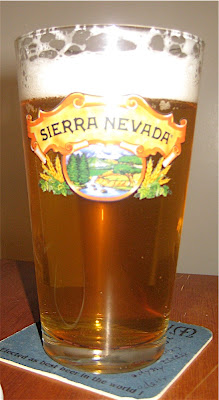Sunday, December 16, 2007
This Blows
I'm trying to brew a Berliner Weisse today and it's windy as hell. Light equipment is blowing all over the place. Add to that the cold (low 50s) and I've been having a hell of a time hitting target temps for this step mash.
Perhaps my wort will chill down faster ...?
Friday, December 7, 2007
SNPA (almost)
The Sierra Nevada Pale Ale clone has been tapped. Not my recipe, though -- it's from a poster on the Northern Brewer forum who goes by the name beerfan.
 Here's the lowdown:
Here's the lowdown:
OG 1.053 FG 1.011
AA 78.3% ABV 5.4%
IBU 38 SRM 8
93% U.S. Two-row
7% Crystal 60
0.4 oz Yakima Magnum 60 mins (19 IBUs)
0.5 oz Perle 30 mins (10 IBUs)
1.0 oz Cascade 10 mins
2.0 oz Cascade flameout
US-05
Brewed Oct. 21
Crash-cooled Nov. 3
Kegged Nov. 11
Tapped Nov. 25
At first it was a little "homebrewy" -- probably from the last of the yeast settling out to the bottom of the keg. The flavor profile continues to clean itself up. I have yet to purchase some real SNPA to do a side-by-side comparison, but I'd suspect it's going to be pretty close. The recipe is, after all, "renowned" (in its own circle anyway) for being a fine clone. If anything, it's possible this beer's hop character is a little subdued compared to the version coming out of Chico.
I've personally felt in recent years that SNPA seems fairly mellow for an American Pale Ale (probably not the case that beer's changed -- just that my tastes have). As such, this clone attempt, especially considering it might fall further on the mellow side, might even be best classified as some sort of "aggressive" Blonde Ale.
But it's all academic. This is a tasty brew no matter what.
 Here's the lowdown:
Here's the lowdown:OG 1.053 FG 1.011
AA 78.3% ABV 5.4%
IBU 38 SRM 8
93% U.S. Two-row
7% Crystal 60
0.4 oz Yakima Magnum 60 mins (19 IBUs)
0.5 oz Perle 30 mins (10 IBUs)
1.0 oz Cascade 10 mins
2.0 oz Cascade flameout
US-05
Brewed Oct. 21
Crash-cooled Nov. 3
Kegged Nov. 11
Tapped Nov. 25
At first it was a little "homebrewy" -- probably from the last of the yeast settling out to the bottom of the keg. The flavor profile continues to clean itself up. I have yet to purchase some real SNPA to do a side-by-side comparison, but I'd suspect it's going to be pretty close. The recipe is, after all, "renowned" (in its own circle anyway) for being a fine clone. If anything, it's possible this beer's hop character is a little subdued compared to the version coming out of Chico.
I've personally felt in recent years that SNPA seems fairly mellow for an American Pale Ale (probably not the case that beer's changed -- just that my tastes have). As such, this clone attempt, especially considering it might fall further on the mellow side, might even be best classified as some sort of "aggressive" Blonde Ale.
But it's all academic. This is a tasty brew no matter what.
Monday, December 3, 2007
Check Your Thermometers
Not too long ago I brewed a beer, pitched my yeast, and thought all was going well. Then about eight days later I discovered fermentation had stopped well above where it should have (63 percent apparent attenuation versus the 78-81 I had been seeing with the same yeast).
I went and checked the thermometer I used to mash in and found it was reading five degrees higher than another one I had. I won't presume the second thermometer to be dead-on, but it does read exactly the same as my house thermostat, so I think it's in the neighborhood.
So what does this mean? I probably mashed closer to 160 degrees as opposed to the 155 I was aiming for. (And I only went that high because I thought the thermometer was actually reading high... HA!)
Moral of the story: check your thermometers. Don't take anything for granted. And if you suspect that a thermometer has been acting up on you and can't be trusted... you're probably right.
Subscribe to:
Posts (Atom)

